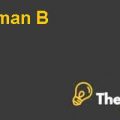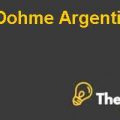Canada pacific ltd Case Study Solution
Canada Pacific Limited
Question 1: Does a conglomerate structure make sense for CPL?
Conglomerates were popular in the 1960s and 1970s, analysts granted premiums when firms operated under this strategy. The conglomerate structure allows management to identify more efficiently new profitable opportunities and it also allows for more efficient capital allocation. A diversified portfolio strengthens the financial structure as the business is able to survive in economic cycles and downturns in the economy. Though it would be safe to say that this type of business structure reduces the risk for the company. This type of structure also has a draw back as company’s main objective is to maximize the shareholder's wealth and this framework enables conglomerate discount, so it could offset management efforts to maximize shareholder wealth.
After the 1970s, the draw back of this structure came to light, Canadian Pacific Limited divested non-core assets and it resulted into an increment in the share price by 50%. Though its share price has been increased yet it has under performed the stock market by 18%.The aim of this paper is to provide the best alternatives in order to eliminate the conglomerate discount experienced by CPL.
Question 2
How are CPL's individual businesses currently performing (financial performance)? Which contributes the most, and the least, to CPL?
Pan Canadian petroleum
Pan Canadian is one of the largest marketers and producers of natural gas and crude oil. The company has the reserves of western Canada and it is the company’s biggest strength.High-quality production, low operating cost are the key value drivers of the company. A rise in oil prices and natural gas makes it the most profitable company of CPL’s business. In the last year, thecompany has reported the revenues of $7.2 billion with net income of $888 million dollars while having the gross margin ratio of 37.07% and Net margin of 12.31%. (See Exhibit 1)
The company has strong financial performance as compared to the other companies of CPL. CPL owns about 86% of Pan Canadian shares and the remaining shares are traded on Toronto stock exchange.
CP Rail
Canadian Pacific Railway provides the rail freight transportation across a22,500 km network across Canada.It is one of the most efficient companies in railway industry while having 70% ratio of operating expense to revenue. The company reported revenues of $3.6 billion with net income of $532 million in the last year while having the gross margin ratio of 42.57% and net profit margin of 14.5%, the second highest of other CPL businesses.(See Exhibit 1)
CPL Ships
Canada Pacific Ships operates inland transportation services and regional ocean roughly on three routes: Latin America, Australasia and Transatlantic. The company reported revenues of $3.9 billion with net income of $532 million while having the gross margin ratio of 23.40% and net margin ratio of 5.85% and also it is one of the ten-largest container shipping companies.(See Exhibit 1)
CPL Hotels and Resorts
Canadian Pacific hotels and resorts are resort and hotel management with over 30000 rooms and 75 properties.A unique collection of premium hotels in Canada’s largest cities is the key value driver of CPHR. The company reported revenues of $833 million with the net income of $197.8 million while having the gross margin ratio of 51.46% and net profit margin ratio of 23.74%, the highest of other CPL businesses.(See Exhibit 1)
Fording Coal Inc.
Fording is a coal manufacturer and distributor of coal and industrial minerals, having three major mines in the province of British Columbia. It is the second largest producer of coal in the world with revenues of $896 million and market share of 14%. The company reported net income of $48 million in the fiscal year 2000 with the gross net margin ratios of 18.9% and 5.36% respectively. (See Exhibit 1)
Which company contributes the most and least to the CPL?
Pan Canadian Petroleum contributes most to the CPL as its contributions in total revenues and profits are 43.68% and 46.87% respectively.
Fording Coal contributes least to the CPL as its contributions in total profits are2.53 %.
(See Exhibit 1)
Q.3: How large is CPL's conglomerate discount? Show how it might be measured?
After the 1980s when the popularity of conglomerates had fallen, conglomerates was trading at the discount of 14% to the sum of the parts of each entity.CPL’s stock market capitalization is $13.2 billion which reveals the conglomerate discount of 12 to 35% of value if each firm is valued individually. In case of the share price of CPL, the internal analysis suggests the conglomerate discount of 10 to 15 %of the value of share price, while external analysis reveals the conglomerate discount of about 25%.
To measure the conglomerate discount in the case of CPL share price, first we have to find out the price per share of each company as according to Salomon Smith Barney valuation, price per share of Pan Canadian Petroleum, CP Rail, CP Ships, CP Hotels & Resorts, Fording Coal, other real assets and cash is $12.57, $10.96, $3.73, $2.78, $2.53, $1.54, and $3.7 respectively. Total asset value accounts for $37.81 per share,however, CPL share price is $30, so according to Salomon Smith Barney valuation,the conglomerate discount consists of 21% of the value.(See Exhibit 2)
CANADA PACIFIC LTD Harvard Case Solution & Analysis
Q.4: What options was the CEO considering to address this conglomerate discount? How did taxes affect the attractiveness of each of these options?
Followings options CEO is considering to address the conglomerate discount
Divest on or more business
Selling one or more of CPL’s businesses would narrow the focus of the firm and eliminate the CPL’s conglomerate discount. To divest one more or more businesses, the company has options to sell to potential buyers of these assets either private equity firms or competitors.
Divestiture does not require any shareholder vote the management of CPL can easily divest one or more than one businesses, it will also generate funds and enable the firm to pay off short-term debt and lower the leverage cost across the other CPL businesses........................
This is just a sample partial work. Please place the order on the website to get your own originally done case solution.











